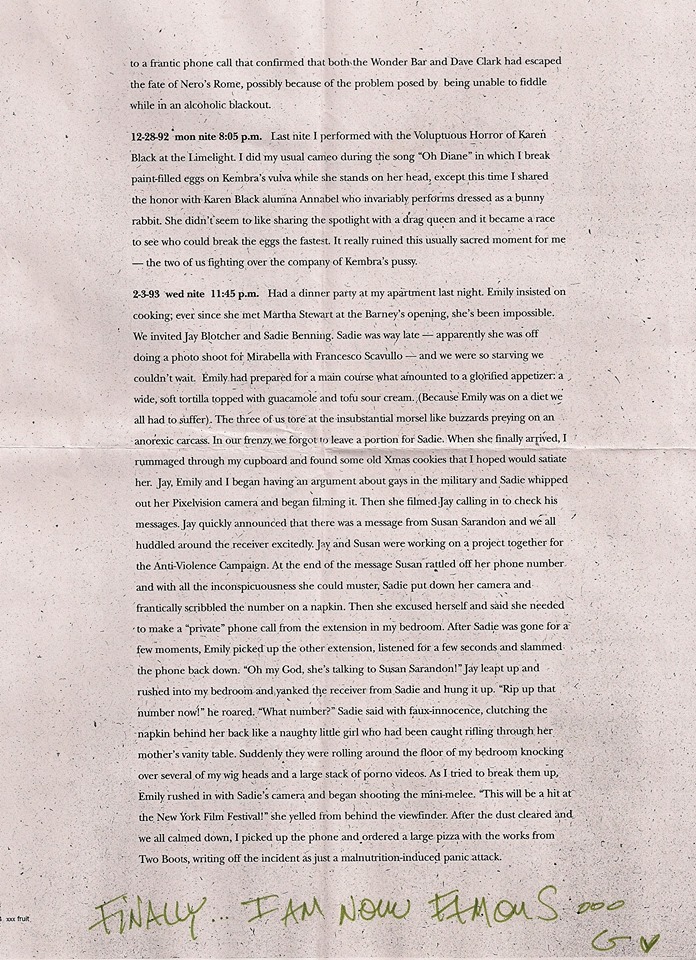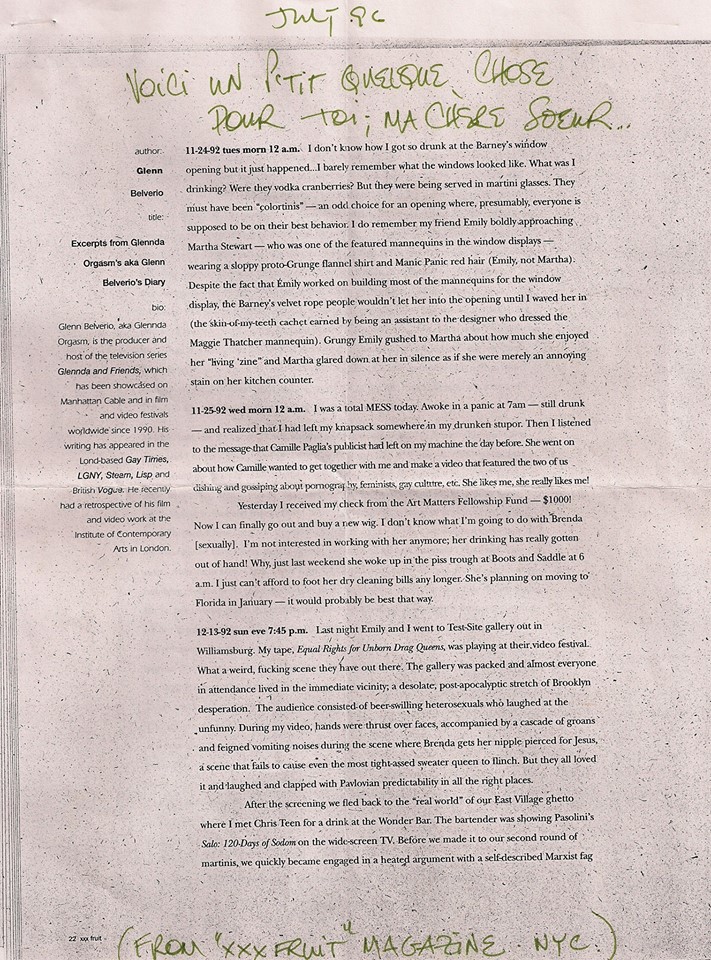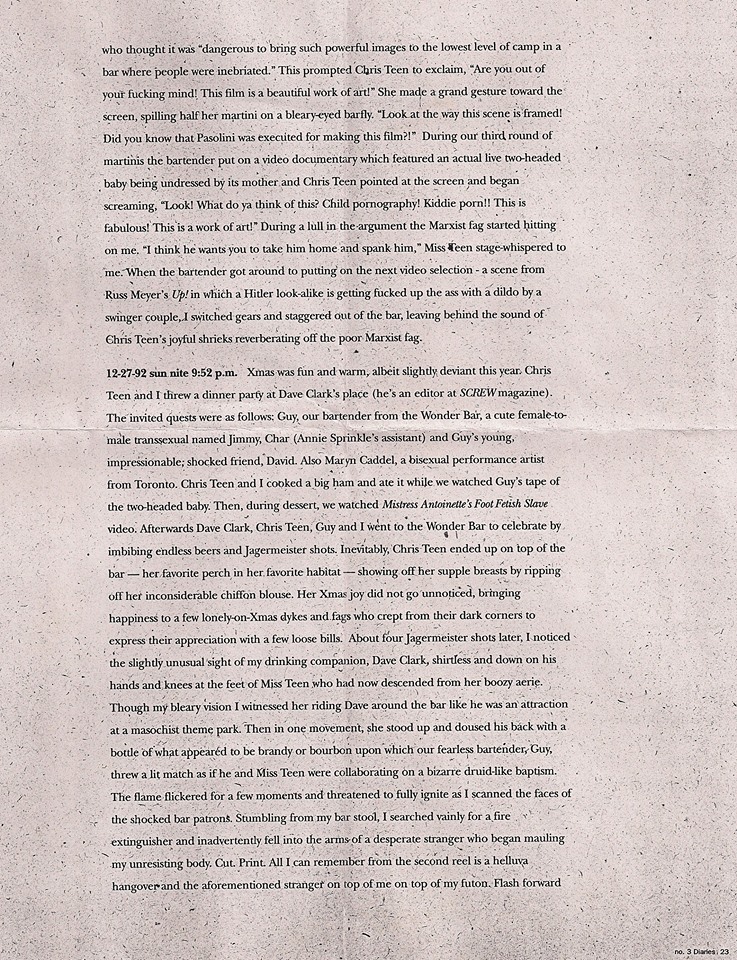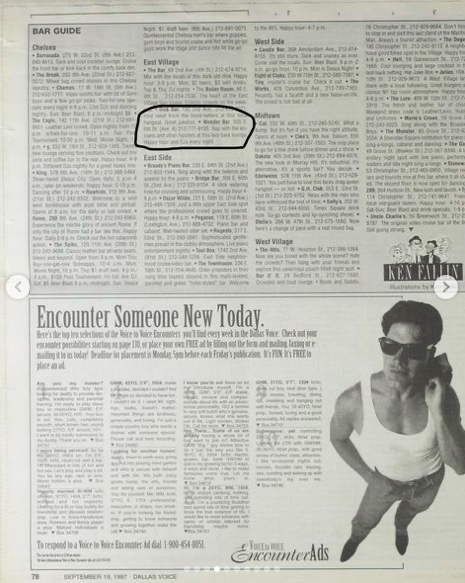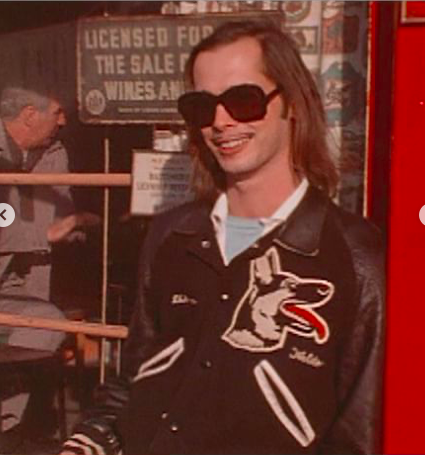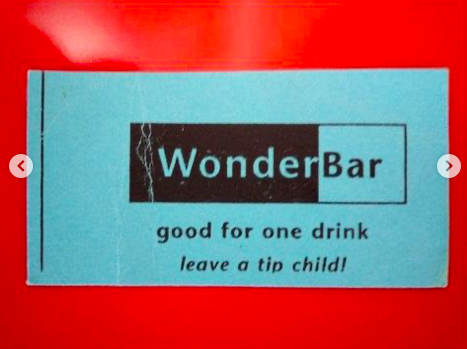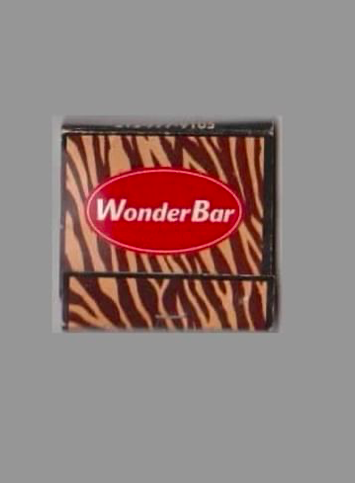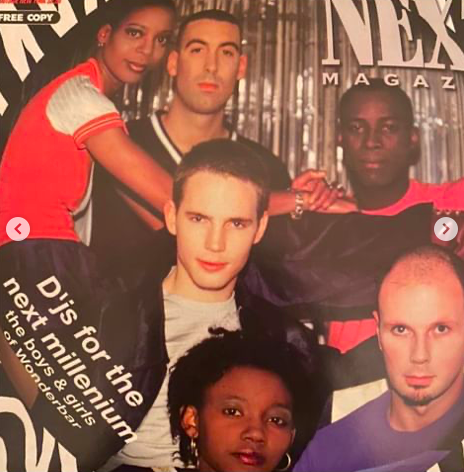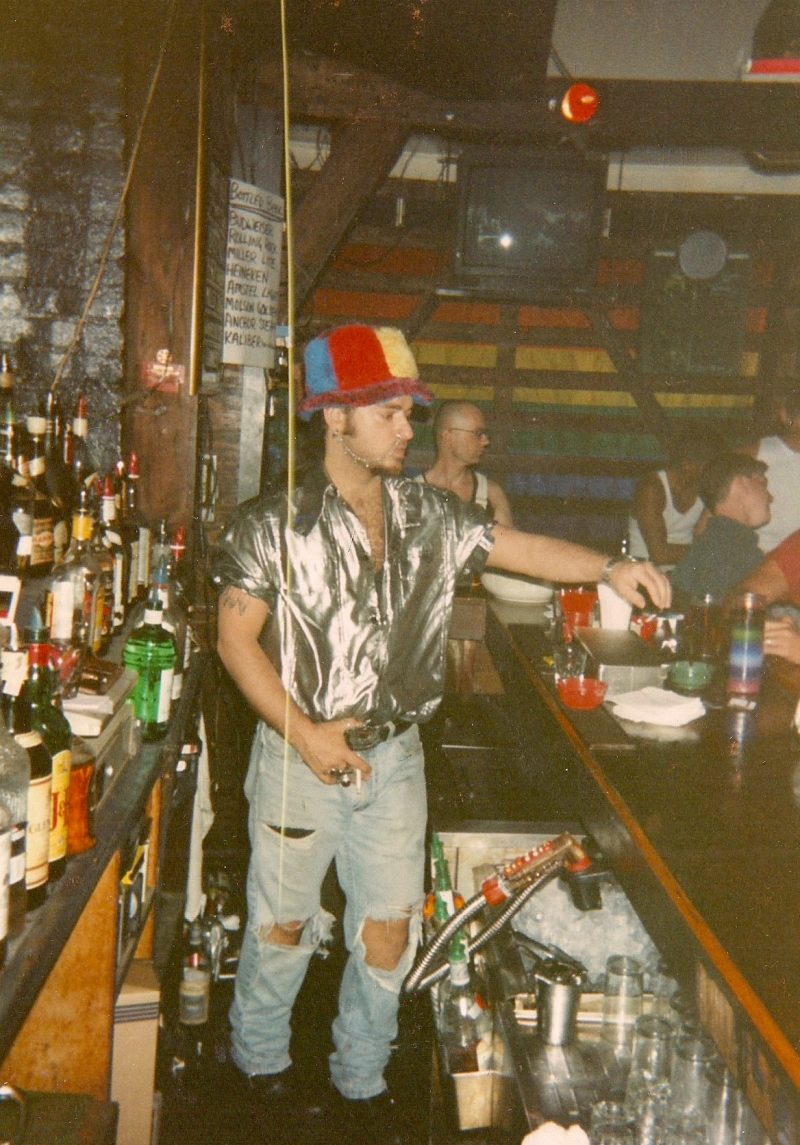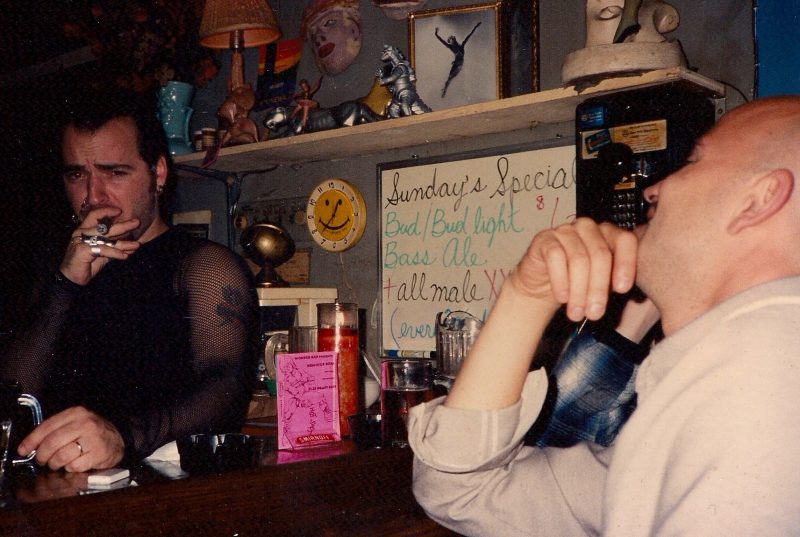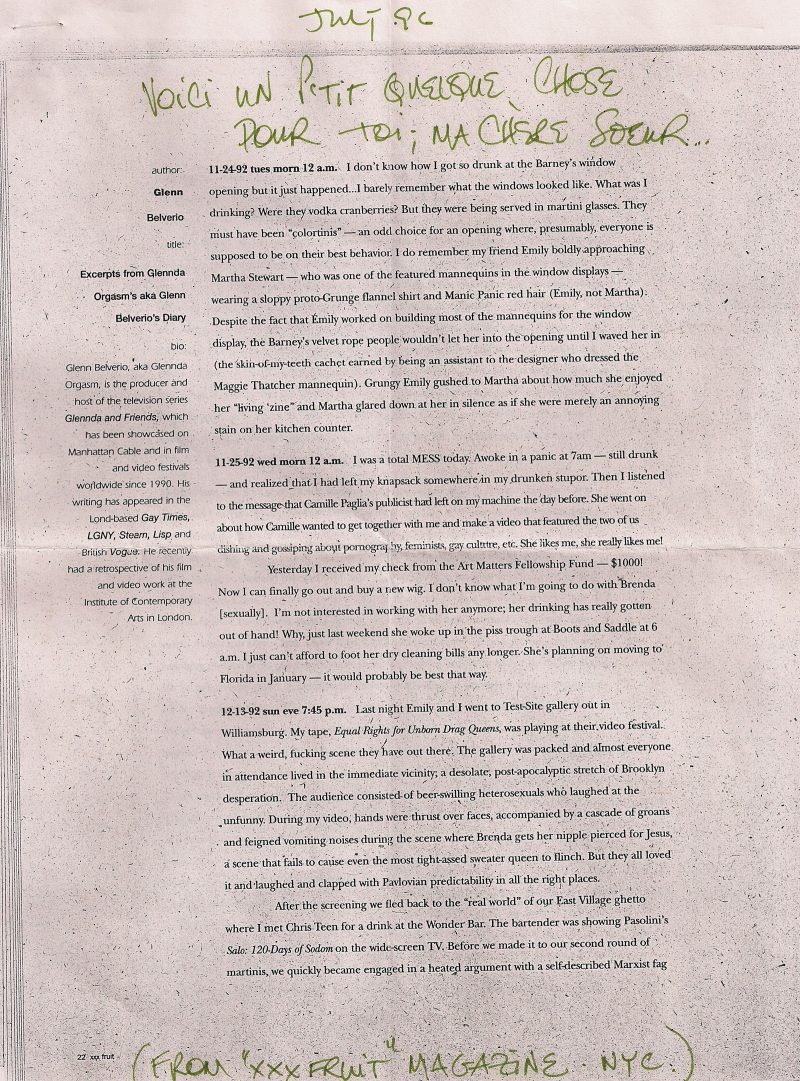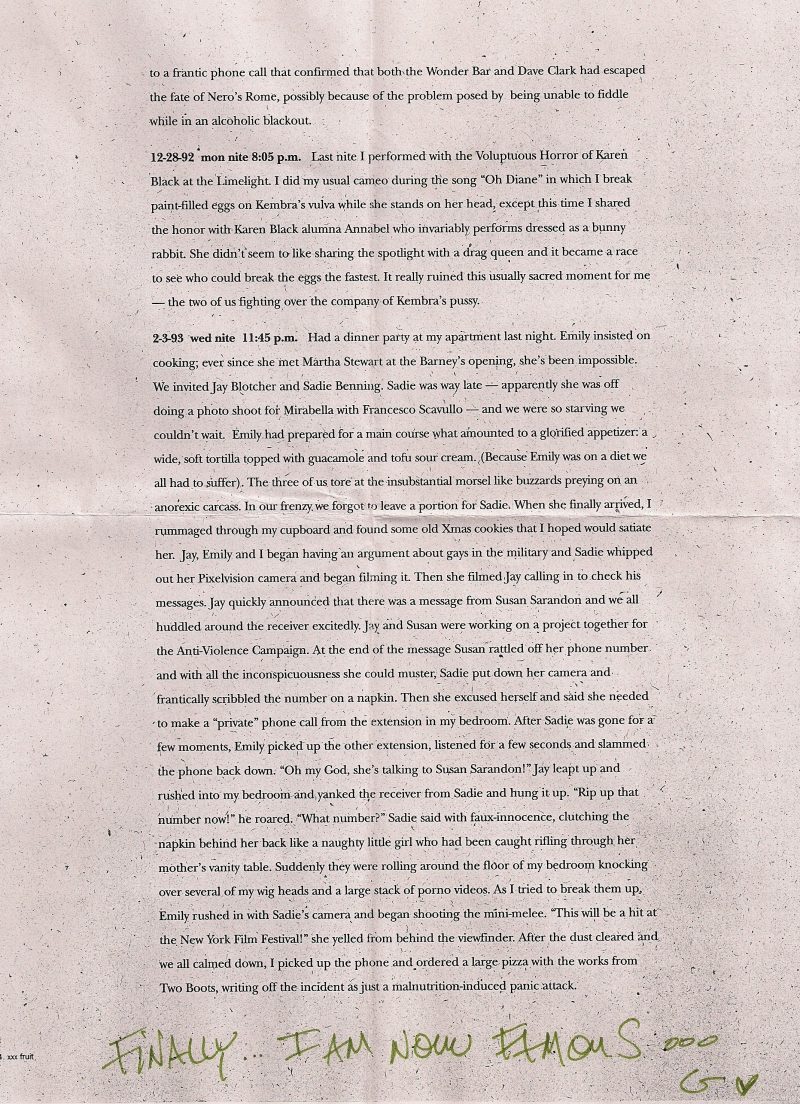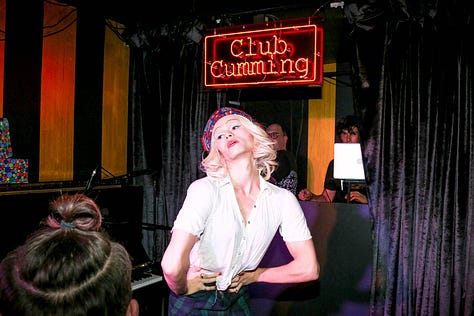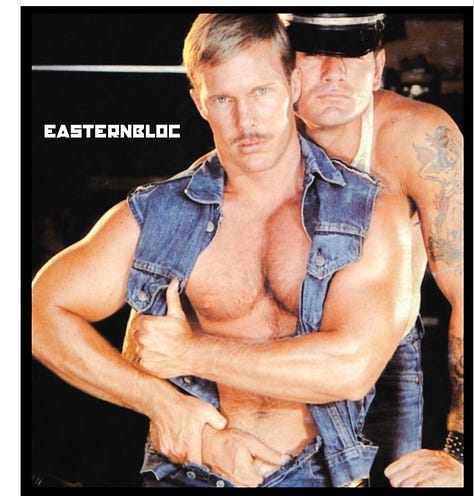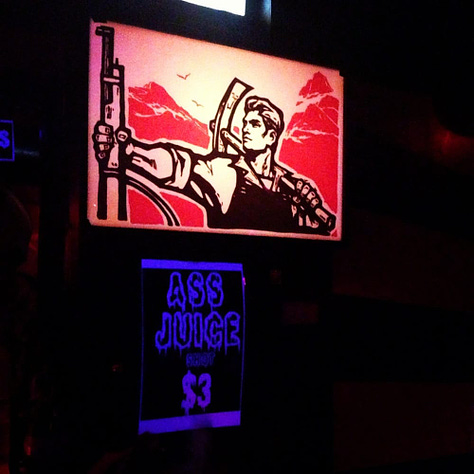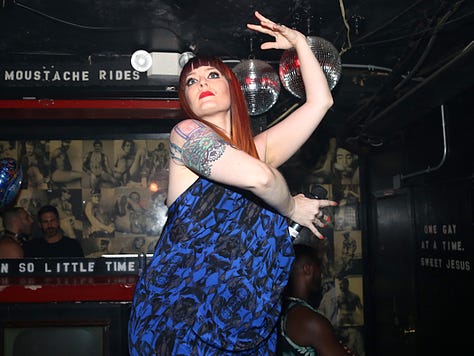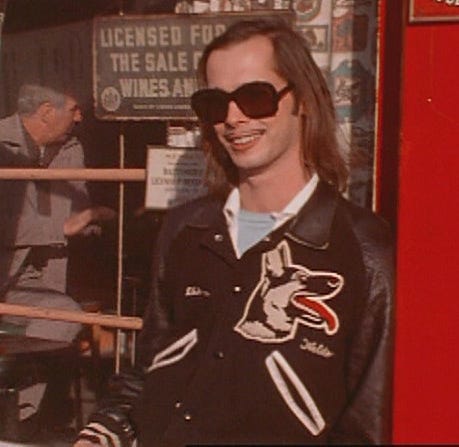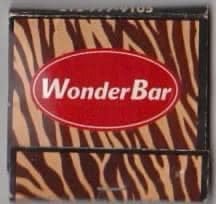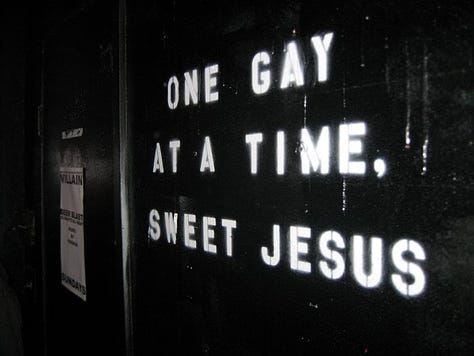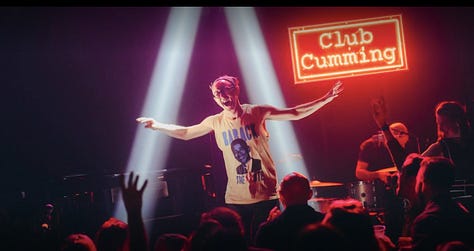Wonder Bar New York 1990-1994
From 1990-1994, I bartended & curated Monday Nights at Wonder Bar in the East Village, Manhattan.
Along with a selection of mixed cassettes & records, I projected hardcore avant-garde films, featuring such local up & coming artists as Bruce LaBruce, with regular clients like Blondie, Iggy Pop, John Waters… I did this for 4 years, alone on Mondays; no door security or other bartenders, no bar back or bouncer. It included a very rough sex room in the back, behind the movie screen, where we dealt with thefts, bloody fights, group sex and more unmentionables. I kept an old wooden baseball for security, which saved my life once, with a machete wielding crazed maniac. To this day, I still own that baseball bat.
Good times.
……………………………………………………………………………………………………………………………………………………………………
Wonder Bar
505 E. 6th St., New York, NY 10009
between Avenues A and B, East Village, NYC, USA
New York Magazine / Night Life Critic: http://nymag.com/listings/bar/wonder_bar/
East Village gay bars come and go, but Wonder Bar has somehow managed to cling to its good standing with downtown’s notoriously fickle fags. The bar originally opened under different ownership in the early ’90s, when a trip to Alphabet City was thought to be an adventure; the neighborhood’s other vanguard gay joints like the Crow Bar and Cake are vague memories now: Yuppification has effectively heteroed the ‘hood. But this little bar that could still attracts a good-sized crowd every night: Everyone from the Cosmo-inclined to Bud boys to Bombay-and-tonic gentlemen still flocks to this grungily stylish and oh-so-friendly small wonder. — Charles Runnette
…………………………………………………………………………………………………………………………………………………………………….
RECENT INSTAGRAM POST by “Queer Happened Here”, February 13, 2023.
Written by Marc Zinaman, New York, USA
Before it became Club Cumming (2017-current) & before it was Eastern Bloc (2005-2017) 505 E. 6th Street between Avenues A & B was home in the 1990s to Wonder Bar (or Wonderbar), a “small, narrow drinking establishment next to the Gladiator Gym…[that] advertises itself as for ‘gay men, lesbians & their admirers.'” Wonder Bar was particularly known as a haven for queer cinema buffs, as it regularly held movie nights there showing campy & classic films via video projection on a large screen. Legendary queer filmmaker John Waters would even sometimes drop by.
Wonder Bar 1st opened circa 1990, taking over the space formerly occupied by The Chameleon in the late ’80s, where pop & jazz bands performed & the city’s homeless artists exhibited their work.
A 1994 NYTimes writeup of Wonder Bar mentions its iconic movie nights: “During a recent double bill of “Valley of the Dolls” & “Beyond the Valley of the Dolls,” the celebration attained the status of ritual. To help audience members empathize with the pharmaceutically inclined characters on screen, plastic pill bottles filled with candy were handed out. Every time someone on screen popped some pills, the audience popped some, too. Although this is a bar, the audience is completely attentive (if noisily appreciative) while the films are running.”
Other film nights at Wonder included showings of “Beyond The Forest” with Bette Davis, “Les Silence Des Damnes” starring Joan Crawford, “Postcards From the Edge” with Shirley MacLaine & “Women’s Prison”, with Ida Lupino, Jan Sterling, Cleo Moore, Audrey Totter & Phyllis Thaxter. Wonder Bar even held a film series on gay & lesbian themes or by gay & lesbian writers called “Lavender Lens.”
In 1998, the NYPost described Wonder Bar this way: “Everything from the checkerboard floors, maroon velvet cushions & grey-&-yellow striped walls is trippy. The deejay spins New Age dance tracks from an elevated hole in the wall every day from 9:30 p.m. until 4 a.m.”
A 1997 writeup in the Dallas Voice mentions Wonder Bar as a popular gathering space for queer women in particular: “Rap with the lesbians & other hipsters at this laid-back lounge. Happy hour & DJs every night.”
……………………………………………………………………………………………………………………………………………………………………
INTERVIEW with LGBT Historic Sites Project, New York, January 2023
Interview by Jen Mohan.
Guy Berube
The Revolving Queer Door at 505 East 6th Street
For decades, the East Village address has continuously housed several beloved LGBTQ bars, including WonderBar, EasternBloc & now Club Cumming
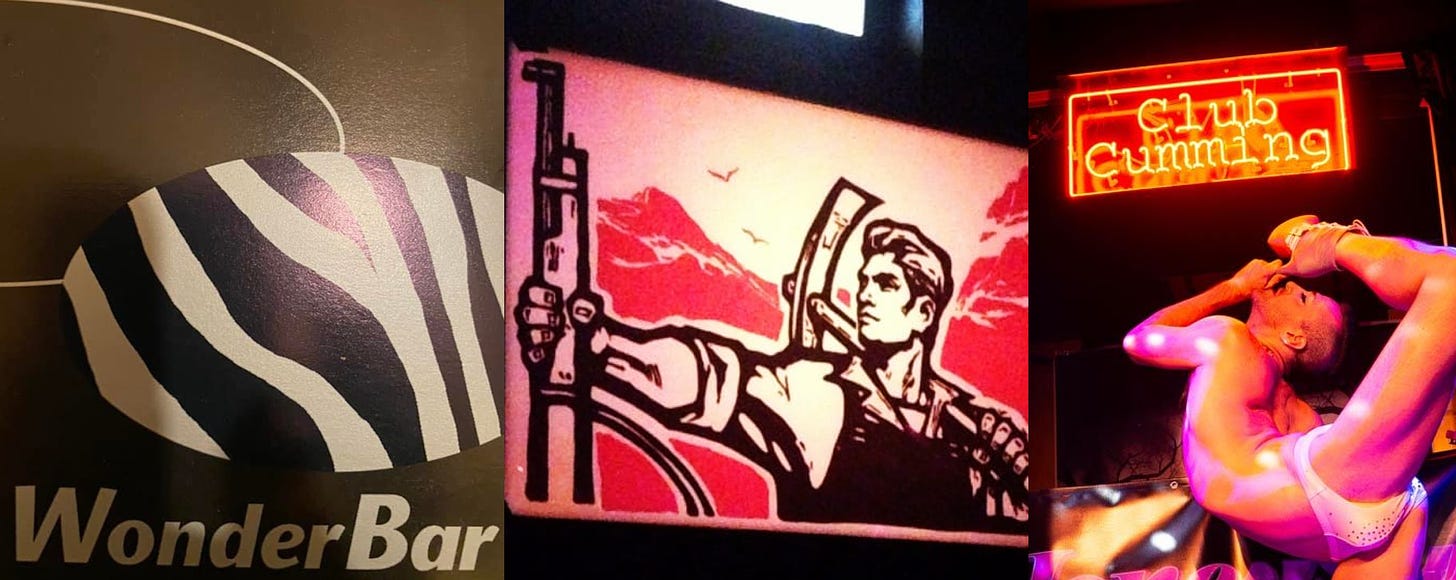
One of my absolutely favorite scenarios that emerges on occasion while trying to document NYC’s LGBTQ history is when a certain address in the City manages to remain a queer destination despite a change in ownership or undergoing a complete redesign. Sure, it can be exciting when a building in New York does a complete one-eighty and goes from being say, a sacred church to becoming a sexy gay mega-club (see Limelight, Sanctuary, etc.) but there is also something really special about a place that becomes a pivotal queer gathering space, closes for one reason or another, and reopens as something new that just happens to become yet another influential queer hangout. It’s even more special when lightning strikes more than once and a space manages to thrive in multiple iterations, becoming a revolving door of sorts of queer history. A sequence of consecutive gay bars in a singular physical space can be especially gratifying for those that get to live through and enjoy the numerous versions, forging queer memories across different venues despite the fact that the walls, floor, and ceiling may be exactly the same. As the saying goes, if those walls could talk, then they might recount having seen you hook up in the exact same bathroom in what were technically three different bars across three different eras.
Such is the case with the dark and dingy retail space at 505 East 6th Street between Avenues A and B in Manhattan’s East Village, which over several decades has a long history of housing several pivotal LGBTQ bars. These include the likes of WonderBar from 1989 to 2002, EasternBloc from 2005 to 2017, and the extant Club Cumming, a primarily drag and cabaret-fueled nightclub that first opened there in late 2017, run by none other than renowned actor Alan Cumming (hence the name) alongside Daniel Nardicio, Darren Dryden and Ben Maisani.

In 2017, Isabel Caballero-Samper for Bedford & Bowery did an incredible deep dive into the early history of 505 East 6th Street, which I’ll try to summarize here, though the full read is definitely worth it. The building at 505 East 6th was likely first built around 1850, when tenement housing began to spring up south of Tompkins Square Park. Early census info shows that in 1860 there were a whopping nine families residing in the five-story building, primarily immigrants from Bavaria and various other German-speaking regions. As early as 1866, however, the ground floor of the building was already home to a saloon, which means that the space that now houses Club Cumming first became a place for folks to party and unwind over 150 years ago.
Subsequent censuses from 1880, 1900, and so forth continue to indicate that the ground floor at 505 East 6th Street remained a saloon through various ownerships. Meanwhile, residents of the building as well as the general neighborhood continued to comprise primarily of European immigrants until post-World War II, when Latino and African-American people began moving into the area. By the 1960s, artists and hippies also started trickling into the region, escaping from nearby Greenwich Village where they could no longer afford to live.
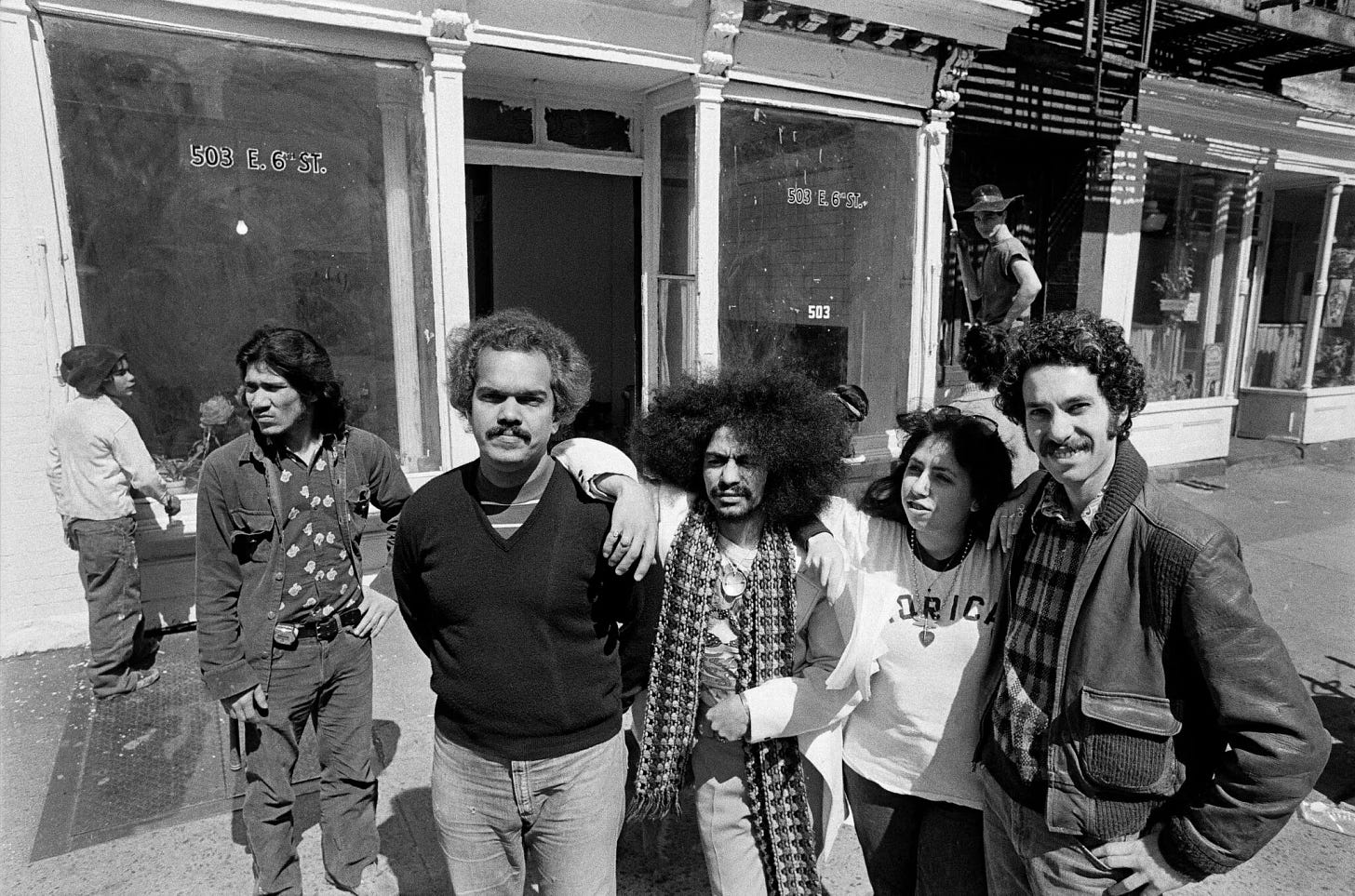
Puerto Ricans in particular began populating the Lower East Side, calling it “Loisaida”, a phonetic interpretation coined by poet Bimbo Rivas meant to mimic how native Spanish speakers would pronounce “Lower East Side.” To date, Avenue C in the Village is still referred to by many as Loisaida Avenue. In 1973, poet Miguel Algarínbegan holding poetry gatherings in his East Village apartment, but within just two years the number of people attending the events proved too many to fit into his tiny residence so he subsequently took over an Irish pub called the Sunshine Café that was located at none other than 505 East 6th Street. The space then became The Nuyorican Poets Cafe until 1980, when overflowing audiences led Algarín and the other poets involved with the Cafe to purchase the building at 236 East 3rd Street (still their current location to date) so as to better expand and serve their various programming.
By the mid-to-late 1980s, 505 East 6th Street had become a venue called Chameleon, where pop and jazz bands performed as well as where the city’s homeless artists were able to exhibit their work. Tom Ward for the Village Voice mentions Chameleon in his 1989 article Village of the Banned,calling it his “fave dive and true psychedelic shack of the NYC late ‘80s.” While surely queer poets, patrons and punks passed through the walls of 505 East 6th Street through its many iterations thus far, the space became officially queer with the opening of WonderBar in 1989.
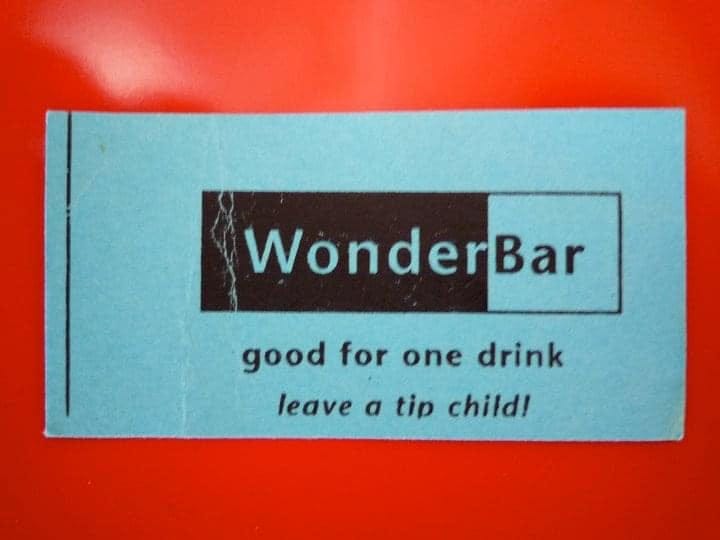
WonderBar (also known as Wonderbar or Wonder Bar) was opened by the late Jeffrey Geiger and and his lover Tim Goetz (both died within a week of each other in the mid/late-1990s). It was described as a “small, narrow drinking establishment next to the Gladiator Gym…[that] advertises itself as for ‘gay men, lesbians and their admirers.'” WonderBar became particularly known as a haven for queer cinema buffs, as it regularly held movie nights there, showing campy and classic films via video projection on a large screen. Legendary queer filmmaker John Waters, known for the campiest of movies like Pink Flamingos, Hairspray, and Female Trouble would even occasionally drop by. WonderBar also hosted a groundbreaking film series on gay and lesbian themes or by gay and lesbian writers called “Lavender Lens.”
A 1994 NYTimes writeup of WonderBar mentions its iconic movie nights: “During a recent double bill of Valley of the Dolls and Beyond the Valley of the Dolls, the celebration attained the status of ritual. To help audience members empathize with the pharmaceutically inclined characters on screen, plastic pill bottles filled with candy were handed out. Every time someone on screen popped some pills, the audience popped some, too. Although this is a bar, the audience is completely attentive (if noisily appreciative) while the films are running.” Other film nights at WonderBar over the years included showings of Beyond The Forest with Bette Davis, Le Silence Des Damnes starring Joan Crawford, Postcards From the Edge with Shirley MacLaine and Women’s Prison, with Ida Lupino, Jan Sterling, Cleo Moore, Audrey Totter and Phyllis Thaxter. Clearly, silver screen divas were a hot draw.
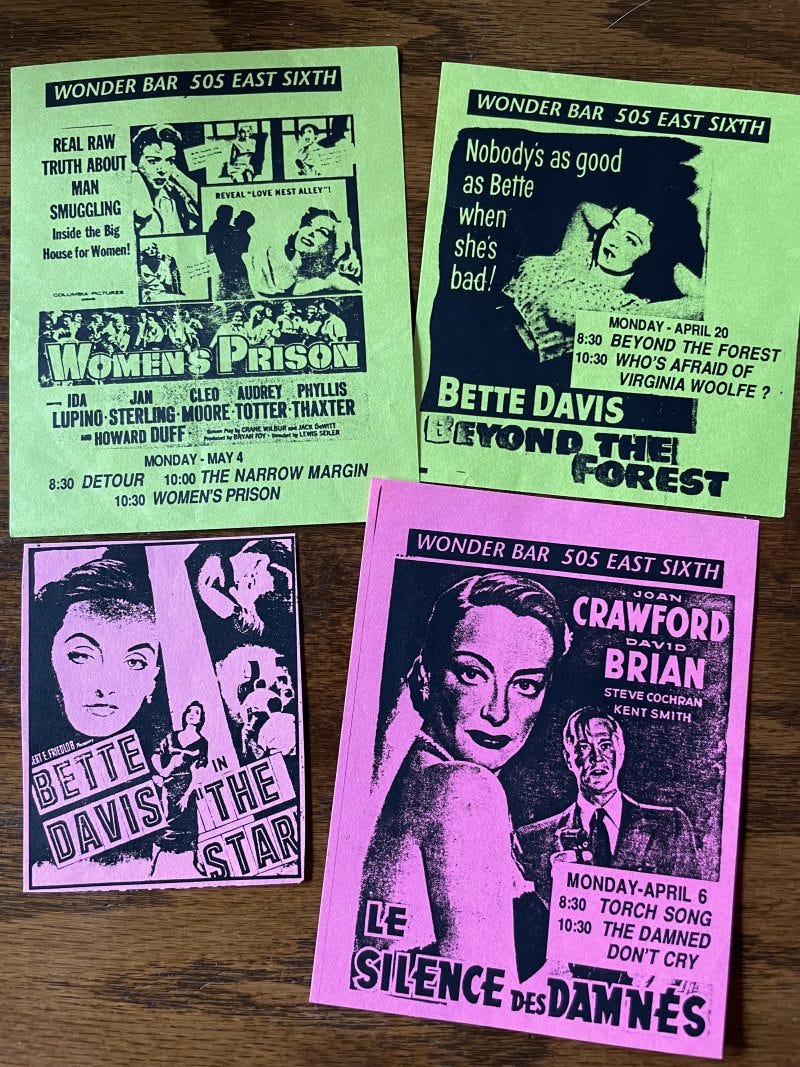
In 1998, the NYPost described WonderBar this way: “Everything from the checkerboard floors, maroon velvet cushions and grey-and-yellow striped walls is trippy. The deejay spins New Age dance tracks from an elevated hole in the wall every day from 9:30 p.m. until 4 a.m.” Meanwhile, a 1997 writeup in the Dallas Voicementions WonderBar as a popular gathering space for queer women in particular: “Rap with the lesbians and other hipsters at this laid-back lounge. Happy hour & DJs every night.” Sharee Nash, a co-founder of iconic parties for queer women and lesbians during the ‘90s and early 2000s like Sundays at Café Tabac and Mondays at Bar d’O was in fact a regular DJ at WonderBar.
Other people who recall working or performing at WonderBar include Jesse Hultberg, who recounted: “Jeffrey Geiger hired me. I bartended there for a year and I’m pretty sure it was 1989. 1990 I left for France and gave my job to Guy Berubé…Singing at WonderBar happened around 1994 after I worked there and returned from France.” Berubé, meanwhile, also recalls working there from 1990-1994, both bartending and curating the space’s Monday night events: “Along with a selection of mixed cassettes and records, I projected hardcore avant-garde films, featuring such local up and coming artists as Bruce LaBruce, with regular clients like Blondie, Iggy Pop, John Waters…I did this for four years, alone on Mondays; no door security or other bartenders, no bar back or bouncer. It included a very rough sex room in the back, behind the movie screen, where we dealt with thefts, bloody fights, group sex and more unmentionables. I kept an old wooden baseball for security, which saved my life once, with a machete wielding crazed maniac. To this day, I still own that baseball bat. Good times.”
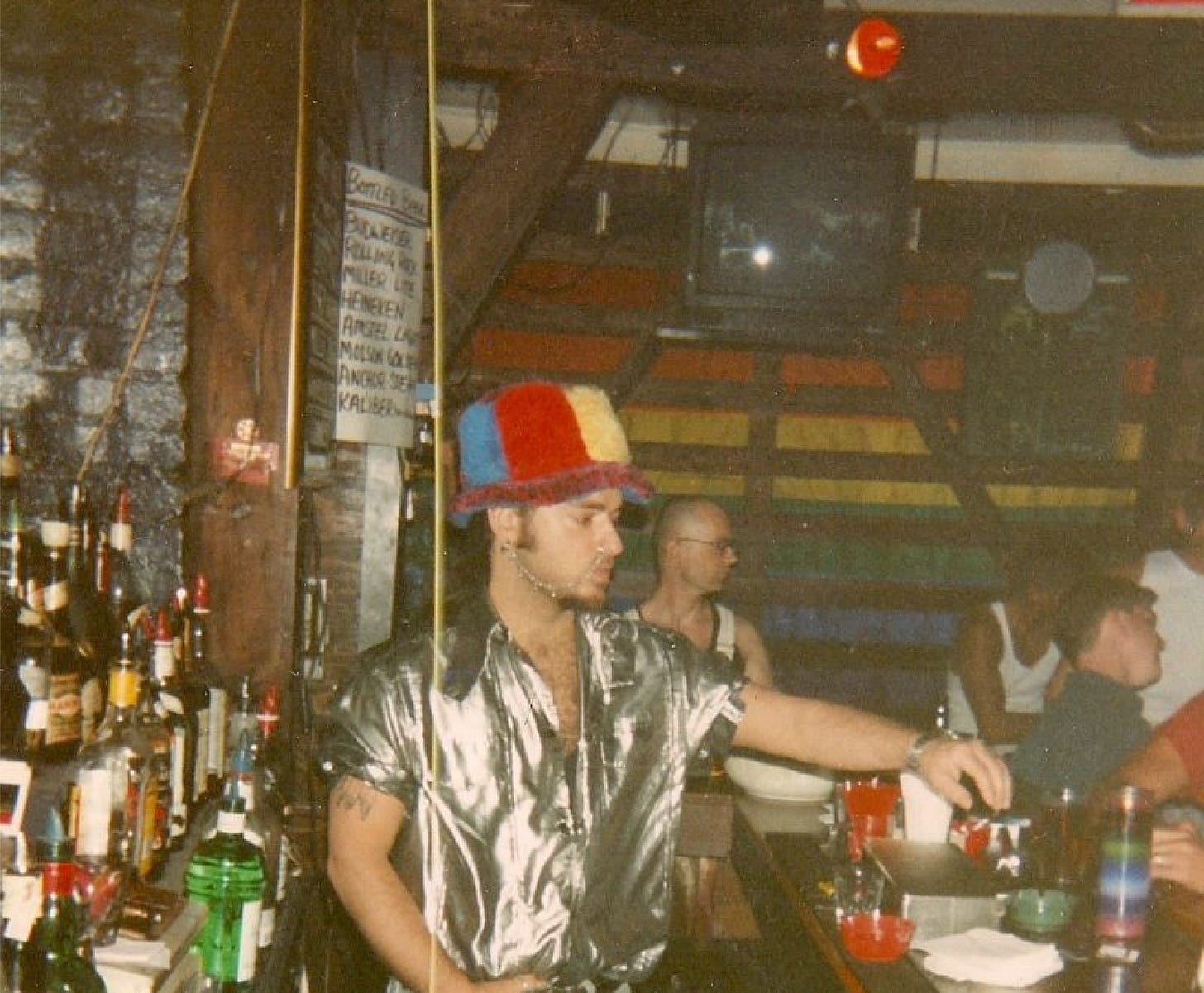
WonderBar officially closed its doors in 2002, perhaps losing steam after the deaths of its initial owners. But 505 East 6th Street didn’t lay dormant for long. After some interior renovations, the space was reinvigorated and reopened as a new gay bar in 2005, the Soviet-themed EasternBloc (or Eastern Bloc). Under the hands of Darren Dryden and Benjamin Maisani, EasternBloc presented as a dingy dive bar mixed with a tiny gay dance club that was splashed in a jokey red-and-black Russian Constructivist paint scheme and theme. The bar exuded a red-light district ambiance, which included raunchy decor, half-naked pole dancers and bad porn playing on small-screen TVs.
EasternBloc particularly attracted a crowd that screamed early 2000s gay hipsters; thirsty, tattooed, slender gay men looking for a dive-y alternative to some of the East Village’s glitzier bars. It frequently drew a sizable late-night crowd to its dark, claustrophobic, nearly windowless, Soviet-themed space and as many patrons will recall, removing one’s underwear and stapling it to the ceiling famously got you a free drink at the bar.
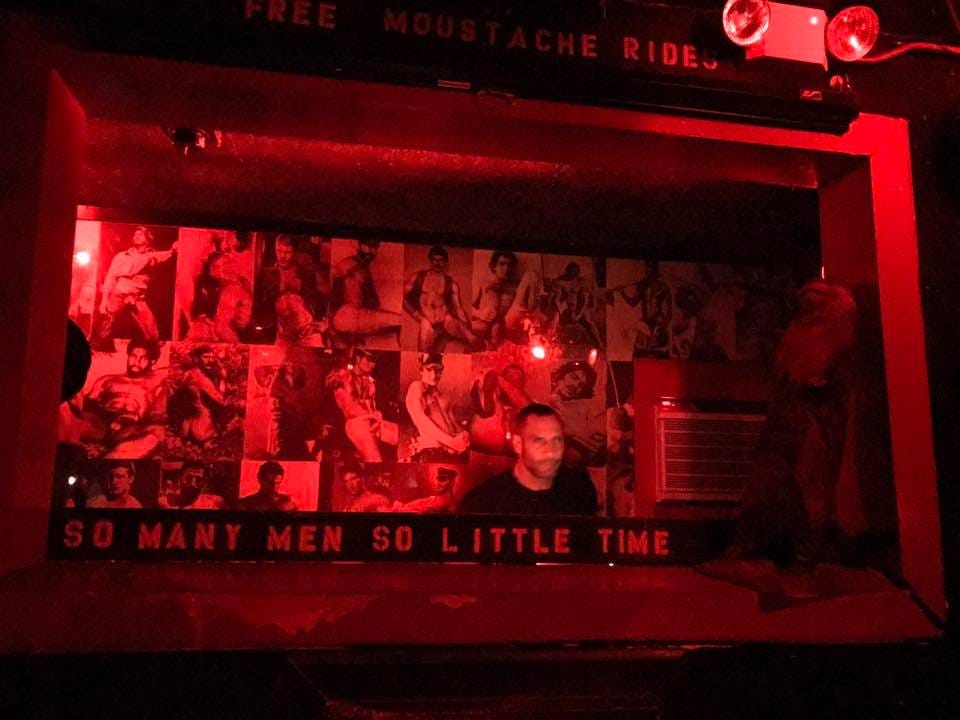
Other memorable features of the EasternBloc space included the animal heads (ye olde famous Zebra); the vintage smut wallpaper; and the bar stools that read GREEDY BOTTOM, ROUGH TRADE, and SAD CLOWN. Additionally, lines for the restroom—labeled the “V.I.Pee” room—were more often than not, atrociously long. Other phrases stenciled either on the bathroom doors or the various other walls of EasternBloc read “One Gay At A Time, Sweet Jesus”, “So Many Men, So Little Time” and “Free Moustache Rides”.
Throughout its time open, EasternBloc hosted a variety of recurring and one-off parties, such as “Planet Uranus” with DJ Marc Isenhart, “Smashed and Mashed Saturdays” with DJ Formika, “RockinDiscoFagBar Fridays” with DJ Darren Dryden, and “Beef Fridays” with DJs Frankie Sharp and William Francis. Under the tutelage of Dryden and Benjamin Maisani, Easternbloc managed to serve the LGBTQ community for twelve years, before closing for good in 2017.
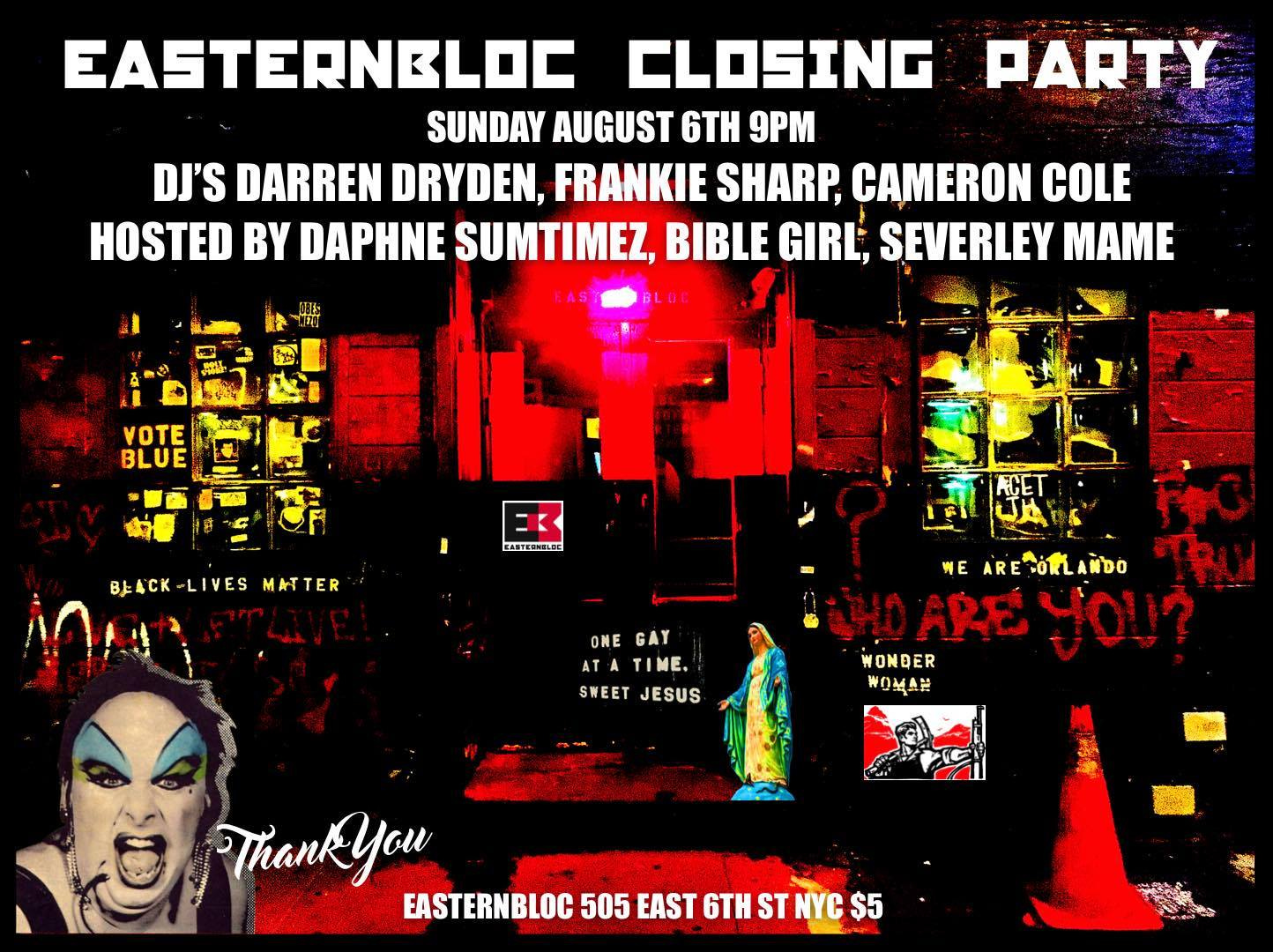
Once again, however, New York’s queer community refused to let 505 East 6th Street die. In swooped celebrated actor Alan Cumming, who in a 2017 NYTimes interview with Brian Sloan stated: “This [EasternBloc] was my favorite bar, I used to be here all the time.” Upon hearing of EasternBloc’s closure, Cumming, who resided only a few blocks away from the bar, decided to take over the space and gave it a Weimar-themed makeover, which included adding chandeliers, velvety drapes and a black and white wall murals painted by Cumming’s husband, Grant Shaffer. One of the murals features Nashom Wooden, who was beloved by many as drag performer Mona Foot and who was a longtime staple of NYC’s queer nightlife scene before his untimely passing in 2020.
Club Cumming’s space is anchored by a small stage upfront that hosts a variety of entertainment and by which hangs the infamous neon red sign that reads “Club Cumming”. Every night at Cumming features at least one event, which can range from live musical acts to DJ sets, lounge acts, drag shows, burlesque performances, go-go dancing, “raunchy readings” and so much more. On occasion, the venue also hosts classical music performances, Broadway acts, and even some fully realized off-off-Broadway musicals. The bar has also countless other miscellaneous events, including a weekly knitting circle called “Stitch & Bitch”, a Romy and Michele themed tea-dance, a weekly drink and draw event called “Anatomy Lessons”, as well as book clubs, piano nights and a gender-fluid dance party called “Femme”.
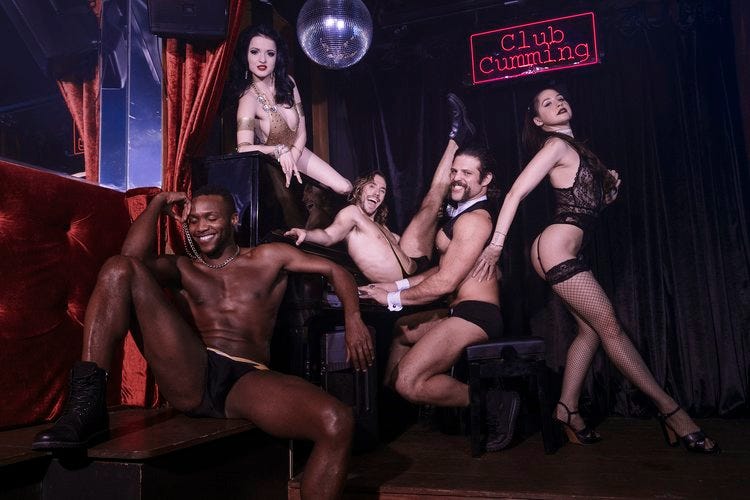
In 2017, H. C. Wilentz for the New Yorker praised Club Cumming for its inclusivity, stating that “[t]he tiny space welcomes a far broader spectrum of the queer community [than most queer nightlife venues] and overflows with a sense of inclusive camaraderie.” Club Cumming also makes regular appearances on countless “Best Gay Bars in NYC” lists, including those belonging to Time Out and ShermansTravel. To date, Club Cumming continues to thrive as a welcoming queer venue with a wide variety of offerings to serve the greater LGBTQ community.
On the club’s current calendar one can find a large roster of happenings including “The Jazz Collective” with Richard Cortez, “Oh Yes! Burlesque” with Tallulah Talons, “The Club Cumming Queer Film Society” and so much more. Find an event that speaks to you, go visit Club Cumming, and next time you’re there, look a little bit closer at the bar’s nooks and crannies and you might just find the layers of queer history hidden beneath.
Subscribe to Queer Happened Here: NYC
https://queerhappenedhere.substack.com/p/the-revolving-queer-door-at-505-east
MORE HISTORY:
Before Club Cumming and the Nuyorican, the Beer Flowed at a Prohibition-Era Church
